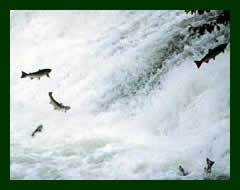|
Landowner concerns about riparian management
alternatives and regulatory constraints ranked high on the advisory
groups' priority list. Case studies provide detailed insights into
the impacts of alternatives not possible from statistical studies
such as the required SBEIS (small business economic impact study).
- The extent and disparity of impacts on small landowners
from the Forest and Fish Agreement is being analyzed first
on six case studies in Lewis County. An economic analysis
of a base case and four management alternatives allowed
under the regulation showed that Total Forest Value losses
ranged from 27% to 36% under the "best case" scenario, and
from 45% to 83% under the "worst case" scenario. With adoption
of a Forest Riparian Easement provided by the state to mitigate
extreme economic impacts, the range of losses could be reduced.
However, the Bare-land Value is reduced to near zero with
any substantial share of acres in the riparian zones and
the riparian easement program does not improve the land
value. For the Fact Sheet related to these studies, click
here.
|
 |
- In order to better understand how these new rules might
affect Eastern Washington small forest landowners, simulations
of forest stand development and economic outcomes were modeled
for seven case studies located in Okanogan, Pend Oreille,
and Stevens counties. The case study sites ranged from 20
to 825 acres in size and from 2100' to 3800' in elevation.
For the Fact Sheet related to these studies, click
here.
|
 |
- Case study findings are being used by the DNR Small Forest
Landowner Office and NIPFs seeking to develop adaptive approaches
to riparian management that lessen landowner impacts while
improving habitat quality.
- Findings of several recent economic impact assessments
were integrated into a presentation on the broader impacts
of new riparian rules. Several presentations were made and
a synopsis appeared in the Society of American Forester's
Western Forester, the Contract Logger's Springboard, the
College of Forest Resources' CINTRAFOR NEWS and its website
(www.cintrafor.org).
|
|










